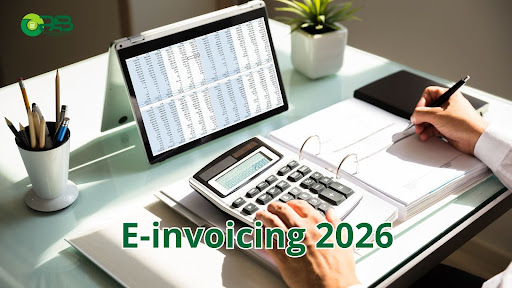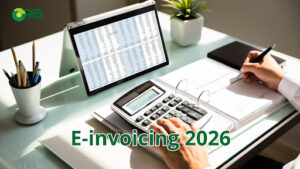The UAE is entering a new era of digital transformation in business. Starting 1 July 2026, the Ministry of Finance (MoF) will launch a pilot program for e-invoicing before gradually making the system mandatory in phases.
This change will redefine how businesses issue, record, and manage invoices across the country.
Whether you’re a startup or an established enterprise, understanding e-invoicing now can help you stay compliant, avoid penalties, and simplify accounting.
Read on to learn what e-invoicing is, how it works, and how your business can prepare before the official deadlines.
What Is E-Invoicing, and Why Is It Important?
E-invoicing, or electronic invoicing, is the process of creating and exchanging invoices in a structured digital format that can be automatically processed by accounting systems.
Instead of using paper or PDFs, businesses will issue e-invoices through accredited service providers connected to the MoF’s platform.
This system is faster, more secure, and ensures accurate tax compliance. It supports the UAE’s goal of building a digital economy and reduces manual work, paperwork, and errors.
How E-Invoicing Differs from Traditional Invoices
✅Traditional invoices are printed or emailed manually and often need human data entry.
✅E-invoices are generated electronically in standardized formats like PINT AE (Peppol International Invoice) for automatic validation.
✅Accredited software handles invoice exchange, reporting, and acknowledgment without manual steps.
Unlike some global models, UAE e-invoicing does not require pre-clearance by the tax authority. Invoices are exchanged between accredited service providers and automatically reported to the MoF.
Why the UAE Is Introducing E-Invoicing in 2026
The UAE Ministry of Finance confirmed that the e-invoicing system will start on 1 July 2026 with a pilot phase, followed by phased mandatory implementation. The project aims to enhance transparency, efficiency, and compliance within the UAE’s tax framework.
Main Objectives of the Rollout
✅Simplify VAT reporting through automation.
✅Reduce fraud by tracking all business-to-business transactions digitally.
✅Improve the accuracy of financial reporting.
✅Support sustainability through paperless documentation.
📚 Also read: How to File VAT Return in UAE: Step by Step in FTA Portal
How E-Invoicing Works in the UAE
The UAE system follows a five-corner model under the Digital Tax Control and E-Invoicing (DCTCE) framework. It uses a decentralized process, where invoices are exchanged through accredited service providers instead of being pre-cleared by the FTA.
Step-by-Step Process
- Step 1: Businesses create an e-invoice using compliant accounting or ERP software.
- Step 2: The invoice is sent through a MoF-accredited service provider (ASP).
- Step 3: Service providers exchange status updates (sent, received, accepted).
- Step 4: A Tax Data Document (TDD) containing invoice data is reported to the MoF.
- Step 5: Buyers receive validated invoices and both parties archive them digitally.
The system uses OpenPeppol standards with the PINT AE data dictionary, ensuring international compatibility and UAE-specific compliance.

Who Needs to Comply with E-Invoicing Rules
E-invoicing applies to Persons conducting Business in the UAE for B2B and B2G transactions. B2C (business-to-consumer) transactions will be excluded at first and introduced later by ministerial decision.
Exemptions and Special Cases
✅Government activities not competing with the private sector are excluded.
✅Certain airline and financial services may also be exempt.
To confirm eligibility, refer to MoF Ministerial Decisions or consult experts like Outsource Prime Accountants and Bookkeepers (OPAB).
Timeline for Implementation
The MoF has outlined a clear timeline for e-invoicing adoption:
✅Pilot Phase: Voluntary participation begins 1 July 2026.
✅Phase 1: Businesses with revenue ≥ AED 50 million must appoint an accredited service provider by 31 July 2026 and fully implement e-invoicing by 1 January 2027.
✅Phase 2: Businesses with revenue < AED 50 million must appoint a provider by 31 March 2027 and go live by 1 July 2027.
✅Phase 3: Government entities must appoint providers by 31 March 2027 and comply by 1 October 2027.
📚 Also read: What is a UAE Tax Identification Number and Why It Matters
Understanding the Five-Corner E-Invoicing Model
The five-corner model ensures secure and transparent invoice exchange between parties while allowing the MoF to receive tax data in real time.
The Five Corners
- Supplier (Corner 1): Creates the e-invoice.
- Supplier’s Service Provider (Corner 2): Transmits the invoice securely.
- Ministry of Finance (Corner 3): Receives summarized tax data for compliance.
- Buyer’s Service Provider (Corner 4): Delivers the validated invoice.
- Buyer (Corner 5): Receives and stores the final invoice.
This design prevents duplication, ensures standardization, and supports audit transparency.
Benefits of E-Invoicing for Businesses
The Ministry of Finance highlights multiple benefits of adopting e-invoicing:
✅ Faster processing and payments.
✅Reduced human errors through automation.
✅ Simpler VAT and corporate tax filing with digital records.
✅ Transparent audits and automatic transaction tracking.
✅Lower administrative costs.
✅Environmental sustainability with paperless workflows.
✅Quicker refunds and pre-populated VAT return fields.
How to Prepare for E-Invoicing
Partnering with experts like OPAB helps ensure a smooth setup with compliant accounting platforms such as Zoho Books, Odoo, or QuickBooks.
Businesses should act now to ensure compliance before deadlines.
Preparation Checklist
✅Review current accounting systems for e-invoicing capability.
✅Choose a MoF-accredited service provider from the official list.
✅Train accounting teams on issuing and reporting e-invoices.
✅Participate in the pilot phase starting July 2026.
Seek professional help from OPAB for setup, data migration, and integration.
📚Also read: Xero Accounting: Streamline Your Financial Management
What Happens If You Don’t Comply
Specific penalties will be outlined in separate MoF decisions, but businesses must comply with UAE tax procedures and maintain complete digital records.
Possible Consequences
✅Invoices issued outside the official system may be invalid.
✅Delays in VAT filing or reconciliation.
✅Administrative penalties for repeated non-compliance once enforcement begins.
To avoid problems, adopt e-invoicing early and maintain regular system audits.
📚 Also read: Tax Compliance in UAE: Complete Guide for Businesses
Common Challenges During Transition
Businesses may face challenges at the start, including:
✅Incompatibility between legacy accounting systems and e-invoicing standards.
✅Data migration errors during implementation.
✅Lack of employee training in new digital procedures.
Working with experienced accounting professionals like OPAB ensures a smooth, compliant transition.

How E-Invoicing Supports VAT and Corporate Tax
E-invoicing ensures accurate, real-time tax reporting for both VAT and corporate tax. Each e-invoice generates a Tax Data Document (TDD) that helps align reported income with actual transactions.
✅Prevents mismatches in VAT filings.
✅Improves audit readiness and transparency.
✅Simplifies tax return preparation with accurate data flow.
This digital framework strengthens financial accountability across the UAE.
Global Models That Inspired UAE’s Framework
The UAE’s system follows global best practices in digital invoicing:
✅Saudi Arabia (ZATCA): Introduced phased e-invoicing to reduce tax evasion.
✅India (GST): Adopted structured invoice validation for compliance accuracy.
✅European Union (Peppol): Uses open standards for seamless cross-border trade.
These global lessons helped shape the UAE’s modern, scalable e-invoicing framework.
Preparing for the Future of Digital Accounting
E-invoicing marks the beginning of a new digital era for UAE businesses. Early adoption ensures compliance, efficiency, and competitiveness.
✅Early adopters gain operational efficiency.
✅Implementation takes time; starting now avoids last-minute issues.
✅Digital compliance gives businesses an edge in the evolving economy.
With help from experts like OPAB, your business can transition easily and confidently to e-invoicing.
Conclusion
The UAE’s e-invoicing rollout is a milestone toward a more transparent and efficient tax ecosystem. It will simplify VAT, improve accuracy, and boost productivity for businesses that prepare early.
If you need expert help setting up accounting software or ensuring tax compliance, reach out to Outsource Prime Accountants and Bookkeepers (OPAB).
OPAB helps businesses across Dubai and the UAE integrate systems like Odoo, Zoho Books, and QuickBooks to achieve full compliance and financial clarity.
Contact OPAB today for customized support that fits your business.
Frequently Asked Questions
Is e-invoicing mandatory in the UAE?
Yes, but in stages. The pilot begins on 1 July 2026, followed by mandatory phases for large businesses by 1 January 2027, smaller businesses by 1 July 2027, and in-scope government entities by 1 October 2027.
What is the rule of an e-invoice?
An e-invoice must be created, exchanged, and reported in a structured format via a MoF-accredited service provider according to the PINT AE standard.
Who is eligible for e-invoicing?
All Persons conducting Business in the UAE for B2B and B2G transactions must comply, except for certain government and financial sectors. B2C will be added later.
What happens if e-invoicing is not done?
Penalties will be issued under upcoming regulations. Businesses may face audits, rejected invoices, or compliance notices under UAE tax laws.









